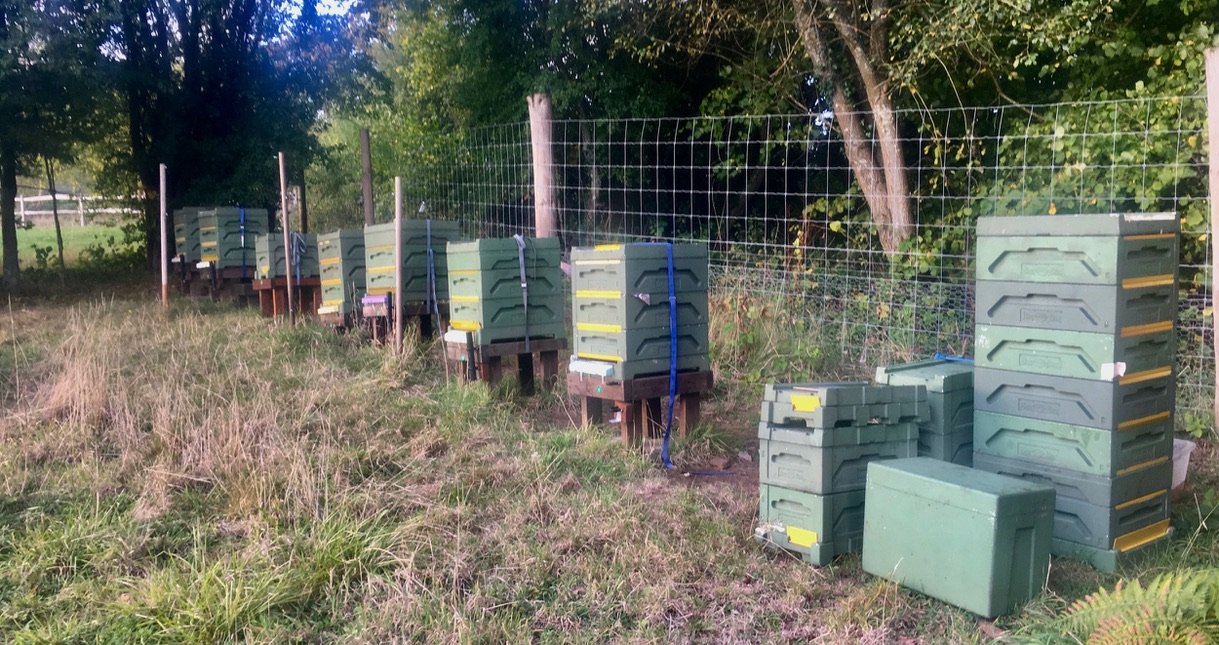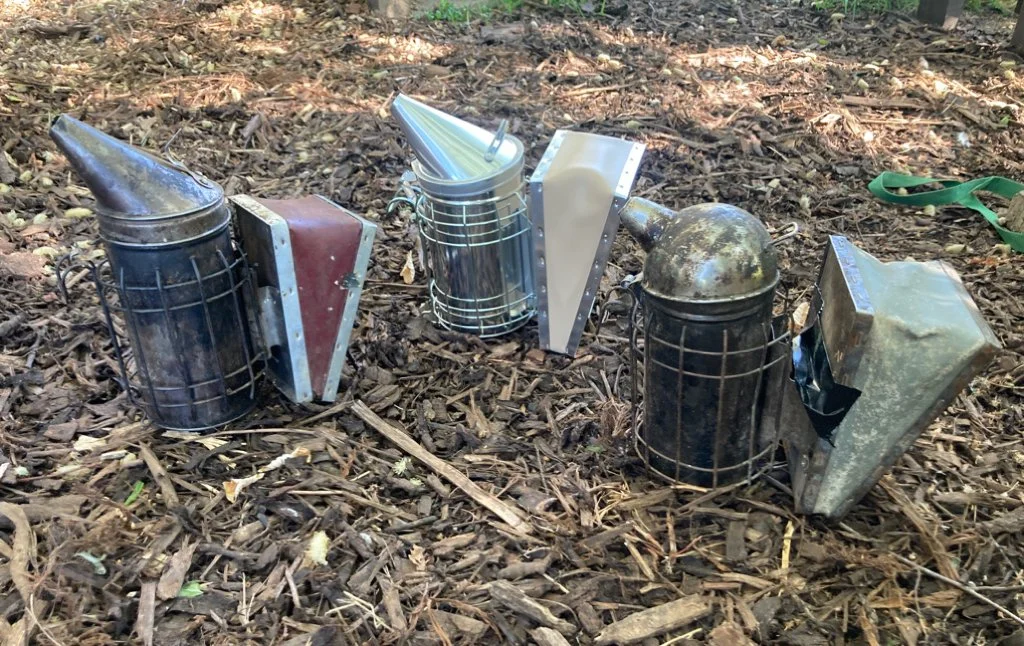
Equipment & bees
All you need
Basic Assessment: Be aware of the equipment needed to open a colony of honey bees and the importance of cleanliness.
Storage
An empty single garage is more than enough initially. Otherwise, buy as big a shed as you can afford, A hive may need five supers and more than two brood boxes. You’ll need a chest freezer, a sink, an extractor, and mothproof containers to store frames. If you start with two colonies, you are likely to have four by the end of your first year.
If you use poly hives you don’t need so much space. I have a garden box to store stuff in my out-apiary; It works well, except during the winter mice do wees and chew holes in everything. Plastic frames and hives are sturdy, so over winter I store them outside wrapped in plastic sheeting, and fumigated with acetic acid. At home, I keep my manipulation boards, a small freezer in my shed, and borrow the Association extractor. I use sturdy, waterproof, boxes (mop buckets) to store frames.
Which hive?
Now, poly hives come as Nationals, there aren’t so many reasons to use Langstroth mediums. The volume in a National deep box is large enough to accommodate all the brood of a colony that is not prolific, but most colonies require two. With mediums, you always require two.
Unless you like pumping weights, Nationals have lighter supers, In addition, they come in supersized 14 × 12 frames, so the whole brood nest occupies one box. Choose poly hives to future-proof your bees against global warming.
Historical temperatures in England by year
@ Crown copyright.
All-in-one plastic frames are available for National deeps, Langstroph deeps, and mediums. I recommend you use wooden frames initially.
My innovation, a queen marking table, can only be used effectively with shallow plastic frames. Deeper frames would tend to topple off.
Consider a horizontal hive if cost is an issue, or you have a dodgy back.
You may feel lonely if you live in England and use Langstroth. If you like to follow the crowd, use Nationals.
If you plan to move abroad, use Langstroth.
To sell nucs in the UK, you need Nationals.
Consider your options: pictures, and descriptions of some hives.
Obtaining bees
In the UK, the most economical way is to tell your Bee Association swarm collectors you want some. Many people buy a nucs despite their cost.
Other options:
Buy a package, a cage full of bees with a queen.
Buy a nuc on mediums — difficult to source.
Buy a National or Langstroth nuc. To move them onto Langstroth frames tie the frames into adaptors and place these in a Deep or two mediums.
Consider doing a shook swarm if you want to move bees from one hive type to another
Use a lure in a box and wait to catch a swarm.
If you buy a nuc from someone who is not a professional beekeeper, it is good etiquette to give them (made-up) frames to replace the ones they gave you; for a National, this means DN4. Likewise, when collecting a queen, provide them with a replacement queen cage.
It is hard work for little colonies to gather enough stores and become sufficiently populous to survive the winter, so make sure your nuc is delivered before the end of June. There is great demand for nucs, so order one in the autumn.
Queens
Aim to buy local bees that are acclimatised to your living conditions. If this is impossible, Carniolans are popular as they are docile, although they have a reputation for swarming, Buckfast are good, but you have to replace them every two years.
To begin with, I bought many queens with the objective of having docile bees. However, when the pure strains bred with the local mongrels, their progeny was psychologically deranged. Since then, I have stuck with what I’ve got, and my queens, are reasonably behaved, although I usually cull one colony each year. Nice queens typically beget nice workers, however, drones are said to strongly influence their children’s temperament (presumably their genes are less heterogenous since they only one set of chromosomes -see bee genetics). Anyway, docile queen can produce grotty daughters.
Hiving your bees
1. Swarm
Put a QE above the floor. Chuck the swarm in, just like a shook swarm. Feed them 4 litres of light /thin or medium syrup (traditionally, give thin syrup it is “as it is for immediate use”). Once they have some brood, remove the QE.
2. Package
Packages are very temperamental, so put a QE above the floor. Stuff the entrance with grass. Then, it is like doing a shock swarm. Consider spraying the bees with dilute sugar syrup so that when you drop them into the hive, they come out of the box as a glob. Hang the queen cage with the fondant exposed (first check whether she is the original queen that headed the colony). Feed them. They can do strange things like fly out and cluster on a post. I’ve only tried two packages. With one, the bees zipped out and clustered on the sunny side of the hive. It was impossible to brush them anywhere as they were sticky with syrup. The next day, they were gone.
3. Nuc to brood box.
A nuc soon runs out of space. Ask the seller for guidance.
4. To a medium box via a Langstroth deep.
Take two medium boxes and put them one on top of the other. Put the Langstroth deep frames that contain the brood at the edges of the top box. Fill in the space with medium frames. As the deep boxes become free of brood, remove them.
5. To any box via a Bailey comb change.
E.g., put deep Langstroth frames or deep National frames (using frame adaptors) into a Langstroth box; feed the colony until it is bustling, and do a Bailey comb change.
Frame adaptor: National deep to Langstroph deep. It is a bit of a fiddle and requires some carpentry.
Up to three National frames can be adapted to fit a Langstroth using this device.
Equipment
Please don’t buy kit too soon. Many people who do an introductory course never go on to keep bees. For the practical sessions, the association should lend you a suit. But once you’ve taken the plunge, you need some serious kit.
Hive tools
If you are absent-minded, buy at least two. None are of any use to me unless painted a bright colour. They can magically disappear even when the grass around the hives is trimmed short. I’ve lost loads. I tried using a metal detector with little luck.
There are standard L-shaped tools and J-shaped tools. Both work fine. The J-shaped tool is good for removing the first frame, and the L-shaped (standard) one is better at moving subsequent frames. Which one you use is personal preference. Clean them in a tub of washing soda between inspections.
Gloves
Avoid wearing gloves if you are brave, have steady hands and amiable bees. Otherwise, your glove options are disposable nitrile gloves, marigold-style washing-up, thick plastic or leather gloves. Nitrile are hygienic but wasteful. Washing-up gloves protect pretty well, but soon fall apart. Thick plastic, leather, or special synthetic gloves are puncture proof, but cumbersome and I fumble frames, Leather gloves are almost impossible to wash.
With most gloves, it is essential to wear gauntlets to stop bees from crawling through the gap where the glove meets the bee suit sleeve. If your gauntlets get lost in the wash, try using old walking socks with the tip of the toes cut off. The socks act as decoys; bees love stinging them. A few people seal the gap between the glove and sleeve with masking tape. Duct tape works well; the bees won’t get into the suit, and you won’t be able to get out of it. When removing plastic gloves, the fingers often get inverted, and it is a devil of a job coaxing them out. The solution is to inflate the glove like a balloon.
Smock
I think you should wear a smock-style suit, to begin with. Make sure it has a detachable hood. These suits are best tucked into your trousers to stop bees crawling up your back. Never mind that it makes you look as if you are wearing nappies. A suit like this is perfect when you have a quick job to do, like filling up feeders when dressing up in a full suit is too much of an effort. Most beekeepers buy quality suits from BBwear or BJ Sherriff.
Once you are confident keeping bees, I recommend you buy a vented suit. They may be expensive, but the joy of keeping bees is lost if you cook because clothes have to be worn under a standard suit. Many beekeepers don’t seem to mind feeling like a boiler fit to burst. Join them or, buy a machine-washable vented suit.
Don’t use a smock with a hole in your crotch.
Hoods
There are three sorts of hoods: fencing (Sherriff) style, brimmed hat and astronaut. The fencing style is the most popular. My reservation about the hat style is that in the evening, on a bright day, one’s eyes are adjusted to bright light, but the rim of the hat casts shade over the comb, making it difficult to see anything. Some hat designs have a bar that obscures one’s line of sight.
When purchasing a fencing hood, check that it flops forward sufficiently so that the bees cannot sting your nose.
Suits may have foibles, which shouldn’t be a problem if you buy British. For example, when I put on my American Mann Lake, the hood was prone to becoming detached. I had to sow stitches (needle and thread in the picture) to restrict the limit of the zip. The suit lasted 10 years.
Vented means that it is like a string vest but with three layers: netting, a rubbery layer that creates thickness and another layer of netting. The width of the material prevents stingers from getting through. Just as with other suits, if you wear it over your clothes (which the manufacturer recommends), you may melt, but if there is a breeze, and you wear it over your skin, you will stay perfectly comfortable. I remain respectable when wearing little clothing underneath (I’ll spare you the details).
The traditional view is that you should buy a suit one size larger than your measurements. This is wise if you have a large tummy. In addition, it allows space for personal growth, but otherwise, it makes a mockery of the manufacturer’s sizing system. The sizing allows for wearing over clothes. Having said that, I bought a larger size and am not too swamped.
Sentinel pro ii from Old Castle farm is a variant of vented suits.
Rather than two layers of netting with rubber sandwiched in between, the Sentinel has an outer net with a denser inner layer. So, it provides more thermal insulation than most suits. It is made from polyester throughout and washes well.
Artificial fibres make me think of the poor girl who burnt like a torch when her nightie caught alight as she warmed herself in front of the fire. Cotton and polyester generally have an ignition temperature greater than 200 degrees C. (partially dependent on the density of the weave) so the fire risk is minuscule.
If possible, keep your suit in damp free conditions; otherwise it gets covered with a speckle of black stuff; presumably some sort of mould. It won’t wash off and looks unsavoury.
Smoker
Practically all the ones sold are large enough. An Empire or Etna 7”x 4” may provide you with smoke all day if you use the best fuel. Try to check how easy it is to remove the bellows, as the chamber may need cleaning occasionally. If the rim get sticky with tar the lid may get stuck. Now that I use sawdust and pet litter pellets, it isn’t a problem. A Dadant burns more fuel and I find it gets encrusted with soot and tar. Burn it off with a plumber’s torch or soak the smoker in washing soda solution (remove the bellows first).
Ensure you buy s smoker with a heat shield (mesh around the chamber). Your main options are Etna, Empire, Dadant, or Rauchboy. I have a Rauchboy, which I received when I ordered an Etna. This has a cylindrical inner container so it contains less fuel. The inset eases the fiddle of the grate falling out. It is nothing special, and I use it like an Etna; it has lasted more than 10 years. The hinge for the lid on both my models went wonky, and I’ve given up trying to mend them. I have replaced the grate with varroa mesh. No ash accumulates underneath. Some beekeepers regard the 10 inch Dadant smoker as the Rolls-Royce of smokers. If you use decent fuel and only keep a few hives, you won’t need one.
Comparison with Dadant smoker.
Both the Empire style (straight pointy spout) and Etna (globular spout) are adequate. They weigh less, and generally produce less smoke than a Dadant. When not in use, they should be like dormant volcanoes except when they get low on fuel, when they produce clouds of smoke. With the right fuel, they rarely go out.
The bellows are attached to the body with screws. After a while, the screws work loose. So the holes gradually enlarge and need replacing with larger screws. Eventually, you’ll need to buy some new bellows.
The Dadant has a stronger build, a good hinge and an extra hole in the bellows. I find it pushes out too much smoke when not in use; Overall it may use more fuel. But, it will suit you if you like using smoke.
This is what I have in my caddy.
I like to have at least two lighters; long length gas hob ones are good and long matches; matches are prone to get damp but do not burn the tip of your finger like a standard cigarette-lighter, a decapping fork for drone brood sampling and a frame clamp (left corner) for pulling out stuck frames. I have not used the clamp for years, but keep it as a lucky charm. A pot for odd bits of wax is handy. Large paper clips are better than cocktail sticks for supporting queen cages. The plastic bag contains a sheet of paper for uniting colonies. Two marker pens for marking queens, frames and boxes, a scalpel for cutting out queen cells, string for tying wild comb into frames, little scissors for clipping queen’s wings. Aluminium foil to protect QC.
Big things
Welly Boots
Water sprayer. Some use hairdressers’ sprayers, although these do not spray enough water to remove bees from poly hive walls.
Use a container of washing soda solution to clean propolis off your hands and hive-tool, as you do your inspections. An old oblong paint container works well.
Billy-can and plastic washing up bowl
Sheet — bedsheet or hessian
Jam jars for wasp traps
Old tennis racket
Bucket for smoker ash
The Matabi sprayer has an adjustable nozzle and when pumped to a high pressure, lasts an age. Hairdresser sprayers only make a fine mist, and the two ones I bought died after little use.
Smoker Fuels
Apifuge is a bee-repellent spray that can be used instead of smoke for brief inspections.
Bee brush
Some people use grass or a leafy twig. I don’t know which planet they live on. I won’t mash my bees with coarse material. Instead, I bought Chinese pig brushes without thinking about animal welfare. Goose feathers are soft brushes, I think too soft, but they are disposable, so if you want a traditional Christmas lunch and some ankle-snapping guards, get some geese.
Jars and water sprayers
Your beekeeping association can buy jars in bulk so that you can save money. A 1 lb (454 gram) honey jar is the commonest size.
Cleanliness
To avoid transmitting diseases between colonies and apiaries do the obvious: wash your hive tool and gloves/hands in washing soda solution, do not leave old comb laying around that may result in robbing. Scrupulous clean your suit, boots, etc. before visiting another apiary.
Next: inspections
BK 2.






















